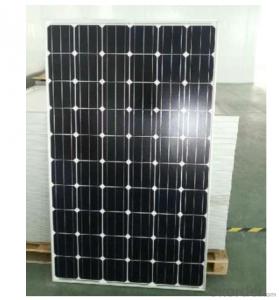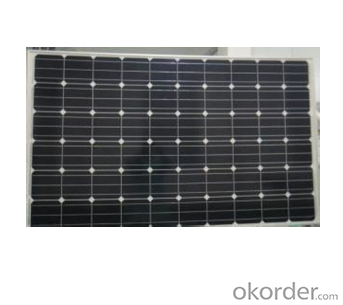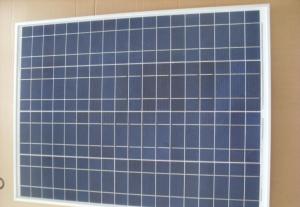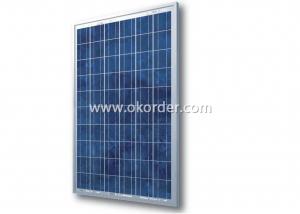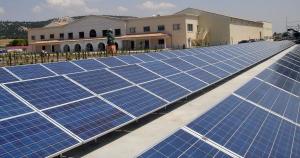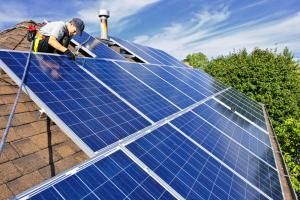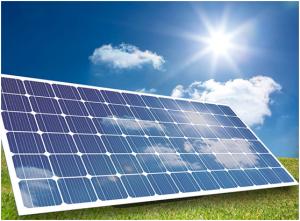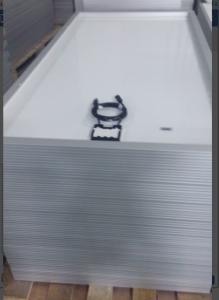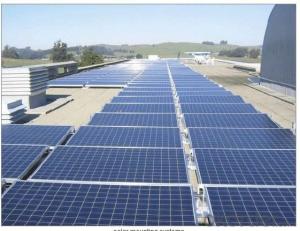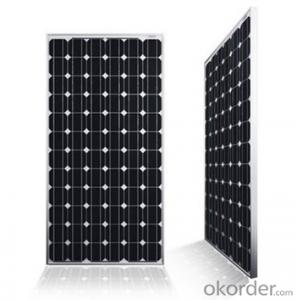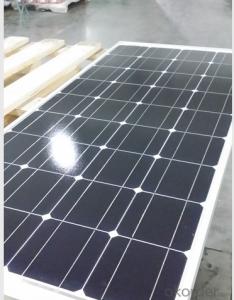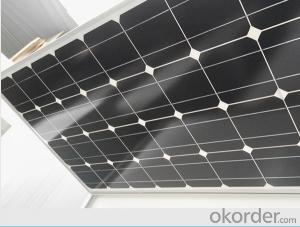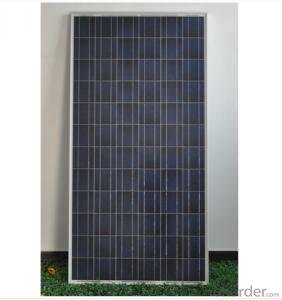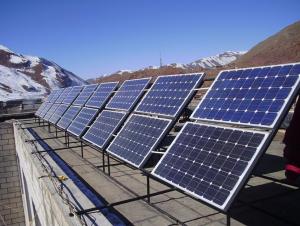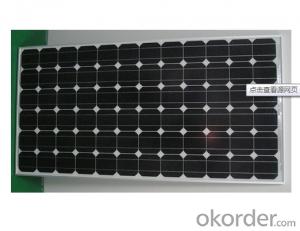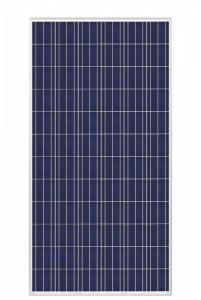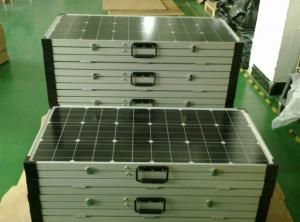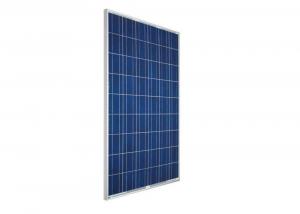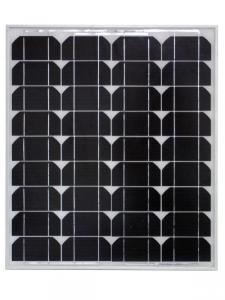Shingle Roof Solar Panels Monocrystalline CNPV-270W High Performance 60 Cell
- Loading Port:
- Shanghai
- Payment Terms:
- TT OR LC
- Min Order Qty:
- 25 pc
- Supply Capability:
- 100000 pc/month
OKorder Service Pledge
OKorder Financial Service
You Might Also Like
Product Description:
Solar Monocrystalline Series Panels
Introduction of Solar Monocrystalline Series Panels
CNBM Solar photovoltaic (PV) Panel is designed for large electrical power requirements. It is the optimal choice for both on-grid and off-grid power systems. CNBM Solar panel offers high performance of power per square foot of solar array. Monocrystalline silicon(c-Si): often made using the Czochralski process. Single-crystal wafer cells tend to be expensive, and because they are cut from cylindrical ingots, do not completely cover a square solar cell module without a substantial waste of refined silicon. Hence most c-Si panels have uncovered gaps at the four corners of the cells.
Standard Test Conditions of Solar Monocrystalline Series Panels
The opto-electrical specifications shown below are stabilized values being measured at Standard Test Conditions, Irradiance: 1000W/m2, Spectrum: AM1.5 at 25°C, The info below is subject to manufacturing tolerances. Where appropriate minutes of measurement are available and are used for the dimensioning of the installation.
Advantages of Solar Monocrystalline Series Panels
• Solar performance guarantees for 25 years
• 12 years guarantee for workmanship
• Timeliness of delivery
Characteristics of Solar Monocrystalline Series Panels
Max Power Voltage Vmp (V) | 31.25V |
Max Power Current Imp (A) | 8.65A |
Open Circuit Voltage Voc (V) | 38.4V |
Short Circuit Current Isc (A) | 9.2A |
Max Power Pm (W) | 270W |
Temperature Coefficient of Cells
NOCT | 47℃±2℃ |
Temperature Coefficients of Isc (%/℃) | 0.064 |
Temperature Coefficients of Voc (%/℃) | -0.33 |
Temperature Coefficients of Pmp (%/℃) | -0.45 |
Mechanical Data Solar Monocrystalline Series
Power | 270W |
Dimension | 1650×992×35mm |
Weight | 18kg |
Tolerance | ±3% |
The dimension of the modules can be changed according to the demand of clients
Limits
Operating Temperature | –40 °C to +85°C |
Storage Temperature | –40 °C to +85°C |
Max System Voltage | 700V |
Guarantee Solar Monocrystalline Series Panels
Products Guarantee | 12 yrs free from defects in materials and workmanship |
Performance Guarantee | No less than 90% within 10yrs and no less than 80% within 25yrs |
Certificates | UL, IEC, ISO, TUV, CE |
The Examination of Solar Monocrystalline Series Panels
FAQ
We have organized several common questions for our clients,may help you sincerely:
①What price for each watt?
It depends on the quantity, delivery date and payment terms,
②What is your size for each module? Can you tell me the Parameter of your module?
We have different series of panels in different output, both c-Si and a-Si. Please take the specification sheet for your reference.
③Can you provide the peripheral products of the solar panels, such as the battery, controller, and inverter? If so, can you tell me how do they match each other?
Yes, we can, we have two companies for solar region, one is CNBM International, the other is CNBM engineering Co.
We can provide you not only the solar module but also the off grid solar system, we can also provide you service with on grid plant.
④What is your warranty system?
Our product performance guarantees for 25 years
• 12 years guarantee for workmanship
• Timeliness of delivery
• Quality Products certified (TÜV, UL, CE, ISO)
⑤How do you pack your products?
We have rich experience on how to pack the panels to make sure the safety on shipment when it arrives at the destination.
⑥ Can you do OEM for us?
Yes, we can.
⑦How long can we receive the product after purchase?
In the purchase of product within three working days, We will arrange the factory delivery as soon as possible. The pecific time of receiving is related to the state and position of customers.Commonly 7 to 10 working days can be served.
- Q: I need to find a way to clean solar panels that automated, at best;A way beside using a large 'squeegee'
- Automating okorder /
- Q: If I put a 5000 watt solar panel kit on my roof in Dublin (Ireland) - how much electricity would I realistically expect to get?An educated guess at a percentage of 5000w would do.
- Build okorder /
- Q: How do solar panels affect the property's energy efficiency rating?
- Solar panels have a positive impact on a property's energy efficiency rating by generating clean, renewable energy. By harnessing sunlight and converting it into electricity, solar panels reduce the reliance on traditional energy sources, leading to lower energy consumption and costs. This increased energy efficiency contributes to a higher rating for the property.
- Q: Can solar panels be installed on swimming pool covers?
- Yes, solar panels can be installed on swimming pool covers. This innovative approach helps harness the sun's energy to power pool equipment and reduce energy costs. The panels are typically lightweight and waterproof, making them suitable for installation on pool covers.
- Q: Can solar panels be used to power a swimming pool?
- Yes, solar panels can be used to power a swimming pool. Solar panels generate electricity from sunlight, which can be used to operate pool pumps, heaters, and other pool equipment. This helps reduce reliance on traditional energy sources and can result in cost savings.
- Q: If not how do they give power to a house/a company?
- Solar panels can be connected to your household wiring with a piece of equipment called a grid tie inverter. You power company will probably require either an automatic or manual means for disconnecting your equipment from their grid in the event of a power outage or line maintainence. Homepower Magazine is an excellent source for information about solar and other alternative energy sources. A primer on the basics of solar electricity can be found using the first link below. You can download a free sample issue of the magazine using the second link below. The sample issue being offered changes occasionally. Don
- Q: What would it take to make a heater for a small solar panel. I am looking into making a heater for a livestock tank to keep ice melted. I know that heaters take alot of energy to run, but my theory is that if heated mirrors on a car can melt ice with low voltage and im sure not extreme heat (40-60 degrees) then making a heater with just high enough temperature to keep from icing over and melting ice is possible. Where do I start? I would like to use an inexpensive solar panel that will generate enough heat to keep ice from forming and melt it at the beginning of the day. How can you make such a heater and apply Ohms law so that it will function correctly, what Wattage will the pannel need to produce to generate enough heat for the heater. The device will only have to be large enough to melt a spot large enough for an animal to drink.
- Absolutely. But I see your point about the Ohms law. I think you'd need technical schematics to get the raw details.
- Q: Can solar panels be installed on a community center or recreational facility?
- Yes, solar panels can be installed on a community center or recreational facility. Solar panels can provide renewable energy for the building, reducing reliance on fossil fuels and lowering energy costs. Additionally, it can serve as an educational opportunity for the community to learn about sustainable energy practices.
- Q: How much space is required to install solar panels?
- The amount of space required to install solar panels varies depending on several factors, including the size and capacity of the panels, the energy needs of the property, and the available sunlight. On average, a typical residential solar panel system requires about 100-400 square feet of roof space per kilowatt of installed capacity. However, ground-mounted systems can also be installed if there is enough space available on the property. It is recommended to consult with a solar installer to assess the specific space requirements for a particular installation.
- Q: China is the world's biggest producer of solar panels
- China is also the world leader in using solar panels. Most solar panels in the US are not from China. There are several companies here in the US that make solar panels, and many states do increase the tax rebate for buying local products. Most flat plate water heating panels installed in the USA are made in the USA. Wouldn't it be nice to get people to buy more sustainable energy products and increase manufacturing jobs in the US, while actually improving the air quality and reducing our dependence on foreign oil? Oh, and perhaps we could get the money by cutting the amount of taxpayer funds subsidizing the oil and coal industries?
Send your message to us
Shingle Roof Solar Panels Monocrystalline CNPV-270W High Performance 60 Cell
- Loading Port:
- Shanghai
- Payment Terms:
- TT OR LC
- Min Order Qty:
- 25 pc
- Supply Capability:
- 100000 pc/month
OKorder Service Pledge
OKorder Financial Service
Similar products
Hot products
Hot Searches
Related keywords
